The gate of the arena is left ajar and the two bulls lock eyes for the first time. Miao Ming seizes the opportunity and begins to charge across the muddy ring before his opponent, Bai Ye Yang, can even cross the threshold. A sharp collective gasp sweeps through the crowd as both bulls are now in full flight – a woman with a baby in her arms stands in their path.
 A woman and her child narrowly avoid colliding with the bulls. Image by Lao Ma.
A woman and her child narrowly avoid colliding with the bulls. Image by Lao Ma.
The faintest touch from either of the 400 kilogram beasts would send her and her baby plummeting off the cliff face and tumbling to the village below. Fortunately, Bai Ye Yang swings right and continues down the village road with Miao Ming hot on his tail. The bulls continue speeding down the street and out of sight and the final bout of the festival ends without bloodshed.
The bull (which is actually a water buffalo) is sacred to both the Dong and Miao ethnic groups, which makes it strange that they pit them against each other. However, for both of these official minorities, bullfighting not only has deep cultural meaning and significance but also enables them to preserve their culture by passing on centuries-old customs and traditions. These traditions are of such importance to them that they reject the idea of monetizing the sport.
Into the Mountains and the Eye of the Bull
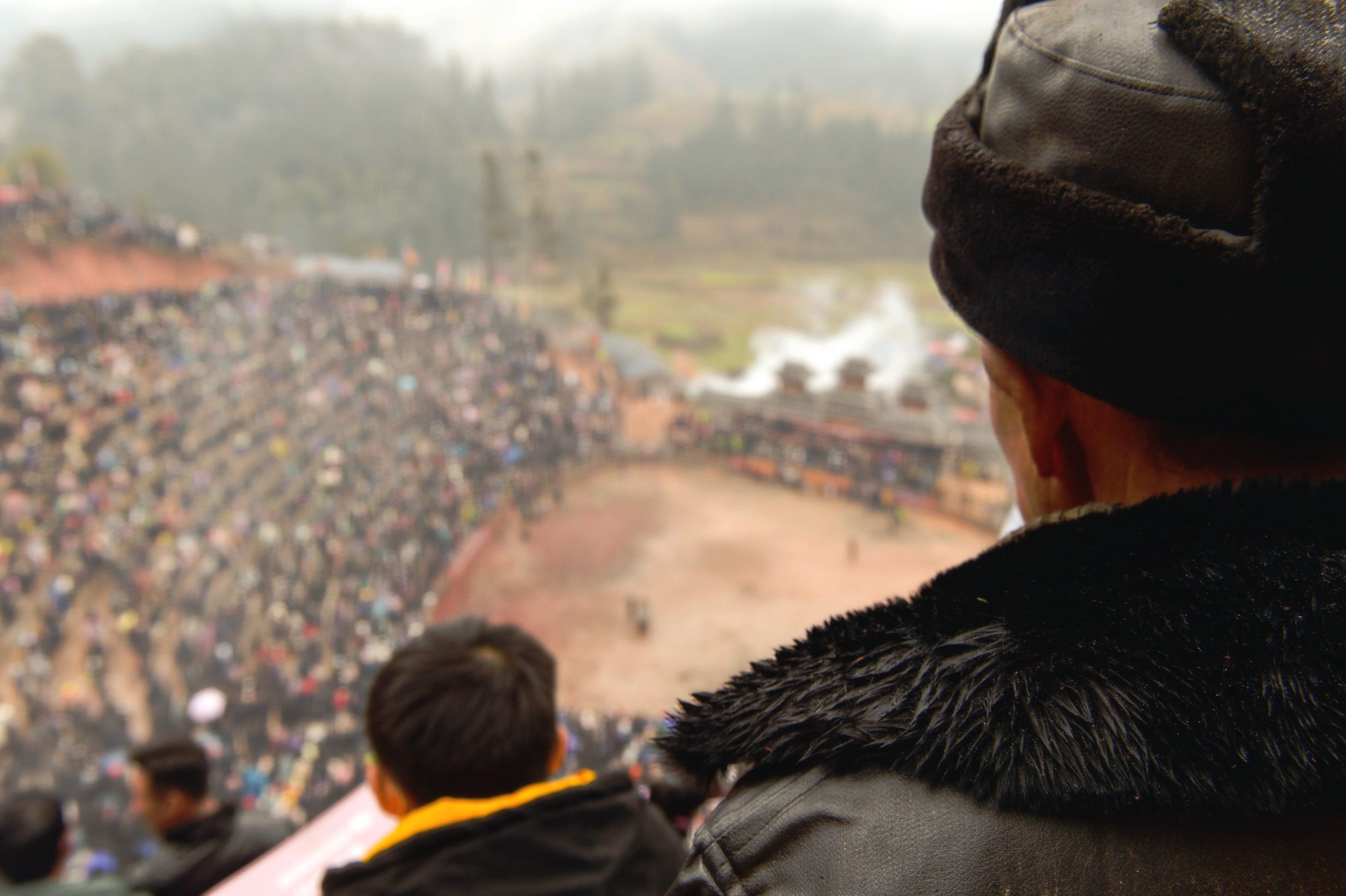 A local watches the event unfold. Image by Lars Hamer/That's
A local watches the event unfold. Image by Lars Hamer/That's
The Qian Dongnan Miao and Dong Autonomous Prefecture is nestled deep in the mountains of southeast Guizhou. To celebrate the end of the lunar year, the village of Wang Dong hosts a bullfighting spectacle that sees 54 bulls go head-to-head over 27 fights.
The arena for the competition had been specially built at an alarming speed; when I arrived three days before the event, the cement was still wet, and locals were working through the night to complete the bull’s eye-shaped stadium.
In Yunnan, Sichuan and parts of Guizhou, bullfights have become a commercial sport. Spectators buy tickets, competitors and sponsors pay to enter tournaments and some people even make a living by uploading videos and live streaming. Sixth Tone reported that bullfighting in Yunnan started to become commercial as early as the 1980s when competition winners were awarded black-and-white TVs.
Prizes later turned into color TVs, DVD players and even fridges, before becoming cash. Nowadays, pay-to-enter competitions have been known to dispense awards of up to RMB160,000. A serial winning bull can sell for twice that amount.
 A champion is born. Image by Lars Hamer/That's
A champion is born. Image by Lars Hamer/That's
In Qian Dongnan, bullfights have no commercial purpose and they are only held during major festivals between January and October. “We have bullfights on the days of hai,” explains Wu Chenglong, an expert on Dong culture. “It is our tradition that we only fight on days of hai in the second, eighth and twelfth month of the lunar calendar.”
The local people in Qian Dongnan want bullfighting to remain a form of celebration and have little interest in fighting for monetary gain.
“If bullfighting developed into this new modern style and the traditional aspect disappeared, I would be very annoyed,” stresses Wu. “This modern style is not pure folk culture and we are likely to lose many traditions and customs this way.”
Bullfighting in the region was not always a form of celebration. Wu explains that the Dong and Miao people believe that bulls were sent from God and they represent hard work and strength, hence why almost all villages in the region have a bull.
Later, the bull became a mediator. Villages were constantly having disputes, fighting and even going to war with each other. During this period, too many young men lost their lives. The villagers decided that, rather than fighting man against man, they would fight bull against bull to resolve conflicts.
Before a bullfight, villagers would welcome their opponent with wine, food and traditional music. This display of generosity showed there was no animosity between opponents. As time progressed and laws were established, village disputes became fewer and fewer, and bullfighting slowly became a form of celebration.
 Local men will play lusheng, drums and cymbals during the bullfight. Image by Lars Hamer/That's
Local men will play lusheng, drums and cymbals during the bullfight. Image by Lars Hamer/That's
In recent years, the Qian Dongnan Miao and Dong Autonomous Prefecture has become more connected to the outside world, bringing significant changes to the lives of local people and minority groups as a whole.
In 2014, when the city of Rongjiang established its first high-speed railway station, Qian Dongnan Miao and Dong Autonomous Prefecture became more connected to the rest of China. Cities such as Guangzhou and Shenzhen can be reached in four or five hours, respectively. By 2018, nearly 1.5 million people from the Qian Dongnan Miao and Dong Autonomous Prefecture were living outside the region, almost one-third of the entire population.
As more young people leave the prefecture, ancient traditions and customs will struggle to live on. Wu reflects on how this could affect bullfighting. “Bullfighting is part of our culture. This sport needs strong young men because only they can control the bulls. If those young people are not here, when their generation gets old, the whole bullfighting culture could disappear.”
Other bullfighting provinces, such as Yunnan and Sichuan, benefit from a large influx of tourism. Meanwhile, precious few know of the bullfighting customs of the Dong and Miao ethnic groups, and tourism to the area isn’t common. The prefecture saw a 30% decrease in the number of tourists visiting the area pre-COVID-19. In 2020, once the pandemic took hold, things only got bleaker, with tourism decreasing a further 60%.
With a decreasing population and a lack of tourism, the Miao and Dong people in villages such as Wang Dong are under threat. So will bullfighting be passed on to future generations?
Without Rules, We are Nothing But Animals
 Little Black Panther having his horns wrapped pre-fight. Image by Lars Hamer/That's
Little Black Panther having his horns wrapped pre-fight. Image by Lars Hamer/That's
Despite bullfighting being a blood sport, considerable measures are taken to protect the animals.
An old man, easily in his 80s and donning a leather jacket with a fur collar, deftly avoids the river of ochre-red mud flowing down the mountain path on either side of the stadium. Despite his age, he makes climbing the near-100 stairs through the middle of the stand look easy.
I look down at my camera and jeans while letting out a dejected sigh; they are caked in mud from the fall I took on my way up an hour earlier. The old man turns to face the ring and looks down with a wry smile, evidently pleased with the seat he’s snagged for the spectacle.
By my side, a young man in a purple raincoat is preparing Xiao Hei Bao – Little Black Panther – for his fight. Like a boxer having his hands wrapped, Little Black Panther is having his horns covered with tape. Taping the horns stops the animals’ skin from being pierced during the fight – another contrast to commercial fights, where trainers have been known to sharpen horns and train bulls to target the eyes.
The Dong and Miao style of bullfighting imposes fines for such practices, and fights themselves are limited to three minutes to avoid injury. A winner is declared when the bull’s opponent runs away in submission. After three minutes, if no bull runs away, the contest is declared a draw. To separate the bulls, villagers hook a rope around the animal’s leg and pull it away from the battle.
The necessity of applying protection to the horns became evident in Little Black Panther’s fight.
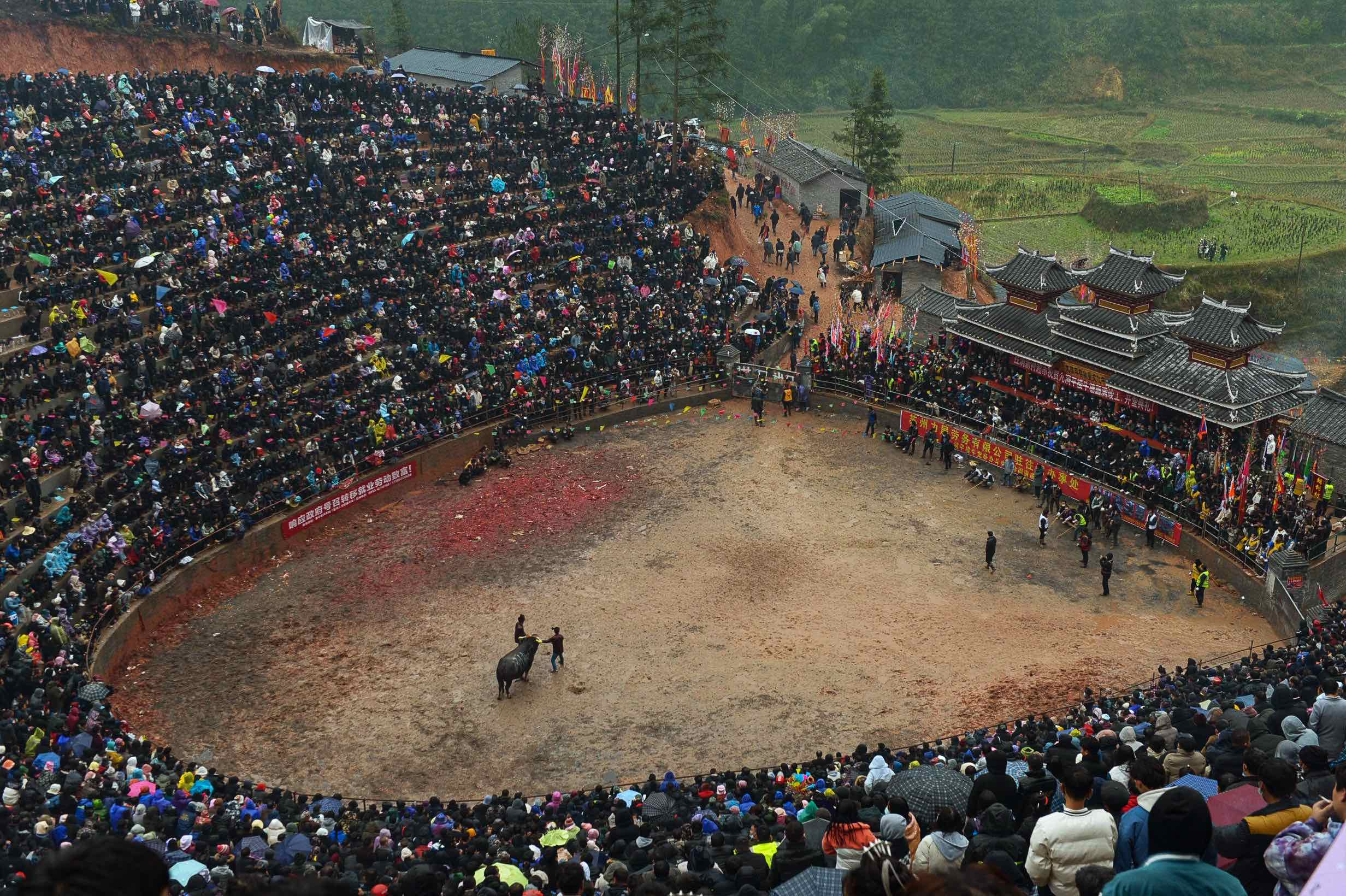 Little Black Panther awaits his opponent. Image by Lars Hamer/That's
Little Black Panther awaits his opponent. Image by Lars Hamer/That's
Standing at the back of the ring, Little Black Panther’s eyes are fixed on the steel gate he has just entered, not in the slightest bit phased by the thousands of spectators surrounding him. In previous fights, when the steel gate opened and the challenging bull came bounding in, more often than not the bull already in the ring would hold his ground, lower his head and take the full force of the collision. However, Little Black Panther is built differently.
A loud cheer erupts from the crowd as his opponent comes running into the ring. Without hesitation, Little Black Panther also starts running. The strategy pays off and, upon impact, Little Black Panther’s head and horns slide under his opponent’s neck, eloquently named Bull 2.
Using his horns, Little Black Panther carries Bull 2 back towards the gate. Bull 2 hits the side of the arena and falls from Little Black Panther’s grasp. Seizing the opportunity, Bull 2 turns and starts to run away. In a matter of seconds, Little Black Panther has won.
Almost immediately, a long horn-shaped scuff mark starts to appear on Bull 2’s leg. It would have undoubtedly been an open wound had protective measures not been taken. Suddenly, something Wu said comes flashing back to me and I wonder if Bull 2’s day is about to get worse. “If it wins, we will kill pigs and goats to celebrate its success. If it loses the first time it’s fine, but if it loses twice, it will be sacrificed.”
Pre-Game
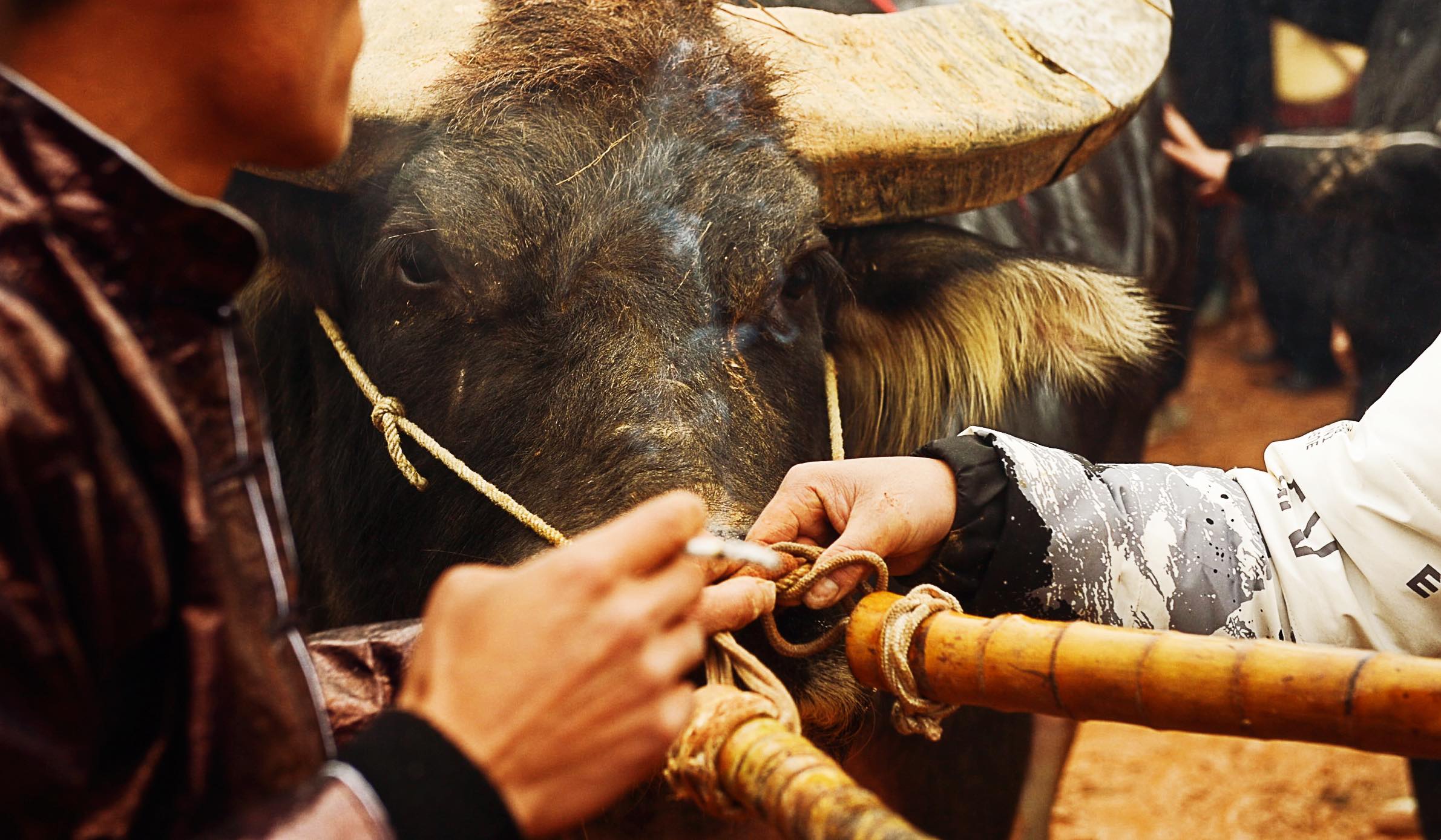 Villagers will walk the bull for miles from the village to the arena in the days prior to the fight. Image by Lars Hamer/That's
Villagers will walk the bull for miles from the village to the arena in the days prior to the fight. Image by Lars Hamer/That's
The rituals leading up to the bullfight are arguably more important than the fight itself. Not only can they be traced back centuries, but they also allow both the Dong and Miao ethnic groups to pass on their traditions to younger generations.
A loud crackle of firecrackers goes off around me as everyone begins to move into place. Small boys holding flags bearing the village name are running up the road towards the drum tower. Groups of men on either side of the stable door start blowing their lusheng (a traditional Chinese bamboo flute), while others rhythmically bash bass drums and cymbals.
Two young men dressed in traditional Dong clothing appear from the stables holding long bamboo canes hooked to the bull’s nose ring. As the bull trudges out of the stable and onto the road, the other village men, in time with the beating of the drum, jump into the air and let out a high pitch scream. In descent, they all slap the bull on the back.
The villagers of Yaxian are conducting the ‘stepping ground.’ The stepping ground is a pre-fight ritual where the bull is taken from its home to the arena. When it arrives at the stadium, it is paraded around the ring before going into a nearby stable where it stays before the fight.
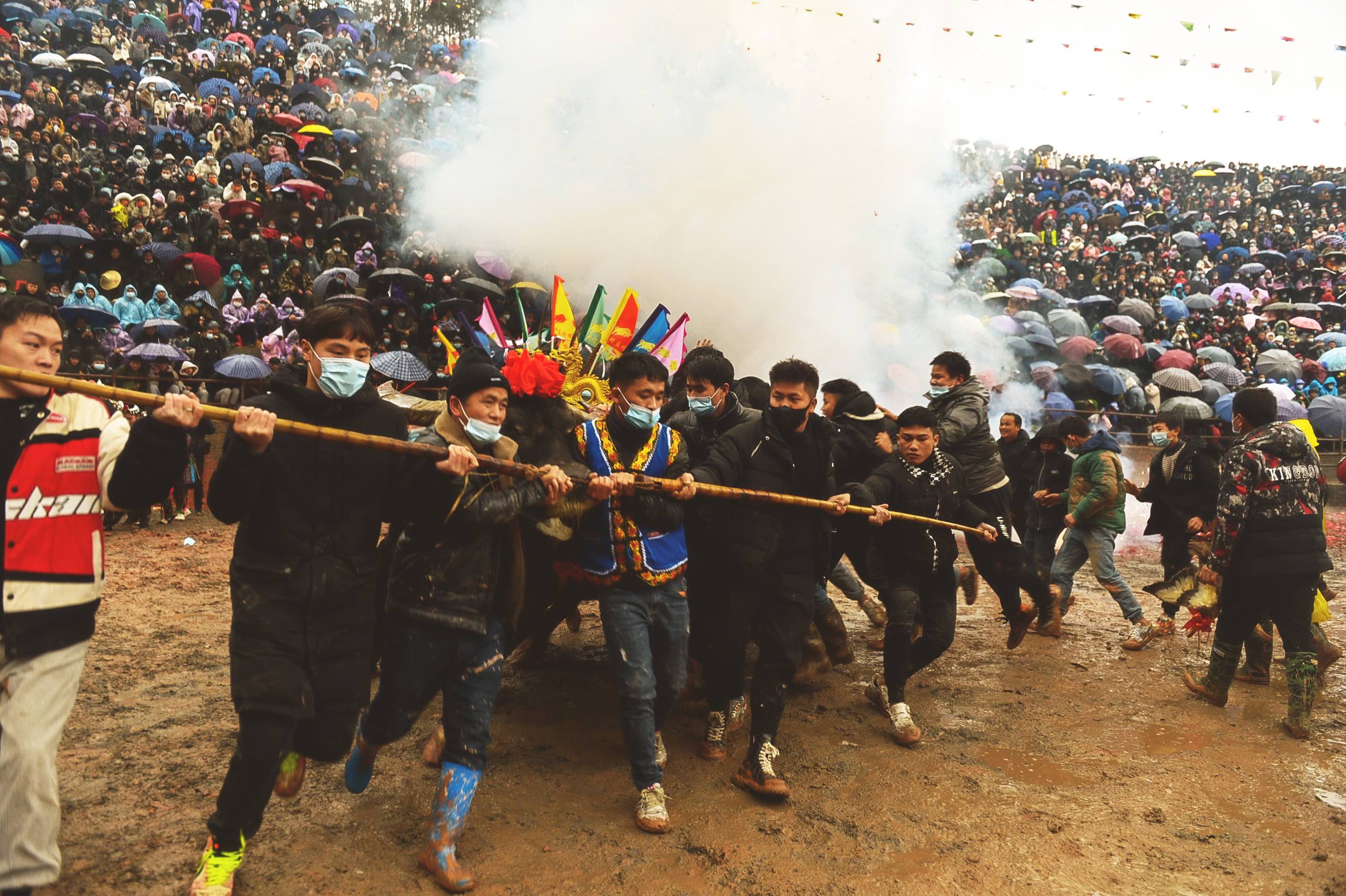
A bull is paraded around the arena before his fight. Image by Lars Hamer/That's
The boys and men of Yaxian will walk the bull through the mountains for more than three hours to reach the arena, despite a single straight road taking them there in half the time. The ritual through the mountain is said to bring good luck to the bull. Unfortunately, this time it didn’t bring any luck at all… two of Yaxian’s bulls lost their fights.
“Those bulls are famous; they’ve won many fights. If they can win again, maybe we can sell them for a good price. The villagers can’t bear to kill those bulls,” explains our driver, a Yaxian resident.
Wu tells us that the village children love the bull and they will help in any way they can to care for it and partake in rituals to be close to the animal. Some village children will form small gangs and learn to play lusheng, drums and cymbals. When they grow up, they will provide music for celebrations during the Spring Festival and other bullfights. For now, they are content with carrying the village flags on the stepping ground.
The music during bullfights is imperative, and you can’t have one without the other. “We beat cymbals and drums and play the lusheng,” Wu tells us. “If there’s no bullfight, then we don’t play the instruments. It’s like a chain. If one link is broken, the chain will not work. If we don’t have bullfights, we don’t have music and vice versa.”
Other village boys work with elders to learn how to feed, walk and clean the bull. Villagers pool money together to not only buy a bull but to pay the man who looks after it. Therefore, the young boys that help the elders have a form of apprenticeship and a job in the future.
“This kind of traditional custom is a way to pass on culture and bring people of the village together,” Wu explains. “We don’t care about how many competitions we have. What we value is friendship and communication between villages.”
Two nights before the bullfight, we went to the arena’s stables to visit the villagers who had already completed the stepping ground and were sleeping in the stables with their bull. We sat with a group of Miao men from Xiajiang village who were in high spirits despite the cold and the arena’s electricity being cut. They had been dining on niu bie, a hot pot style meal that consists of undigested grass from a cow’s stomach and washing it down with homemade rice wine.
To be polite, I necked several glasses and got very drunk very quickly. I paid the price the next day; the few locals that weren’t surprised to see a foreigner were surprised to see one throwing up.
The Spring Festival Bullfight

A woman records the fight. Image by Lars Hamer/That's
Stepping outside of the hotel my watch beeps: 6am. The rain is still only coming down in a slight drizzle, but its constant downpour over the last 24 hours has led to a stream of red mud flowing down the street. As we walk down the street, the cold air pierces through my coat and into my chest, taking my breath away. Despite the weather, the ghost town we arrived in three days ago is now a carnival.
Hundreds of people are lining the streets, marching towards the Ping Liu bullfighting arena. The stalls that had started to appear along the roads the previous evening have bred by the hundreds. Both sides of the one-lane mountain road are spilling over with vendors selling barbecued meats, toys and ice cream.
Between the rows of stalls, villagers have knocked up make-shift tents. Those that aren’t still drinking have passed out from too many the night before. A little boy in front of me tugs on his mother’s hand as she haggles over some foldable chairs, a red bull’s head stitched on the back of his coat.
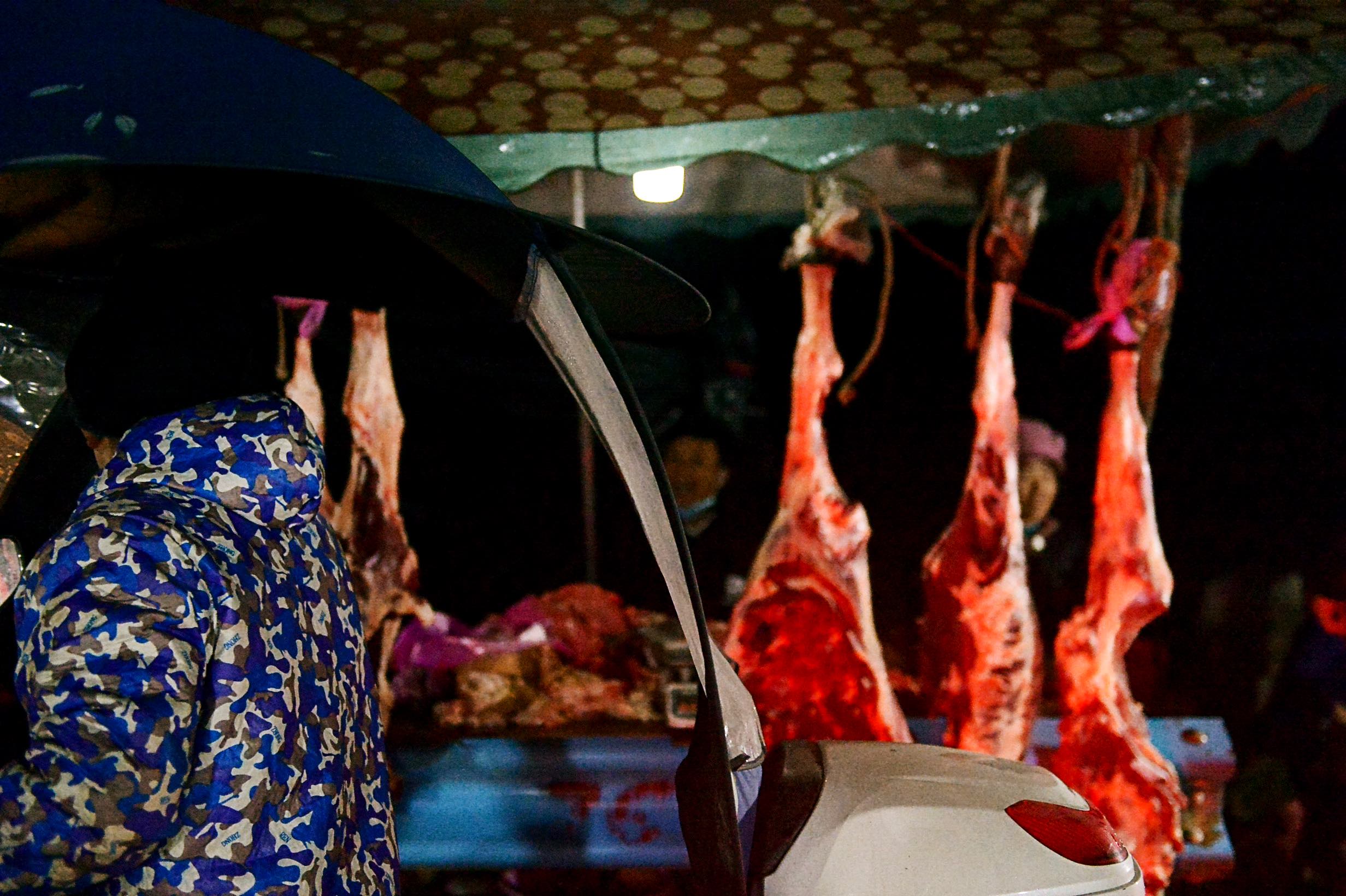
A man on a scooter stops to buy some meat. Image by Lars Hamer/That's
After several slips up the muddy path, my clothes and camera are covered in mud, but I make it into the arena. The sheer volume of people is blocking out the phone signal, making it impossible to get in touch with anyone or use WeChat to buy some skewers of meat or fried noodles. With my press pass hanging around my neck, I step into the bull pit ready to witness 27 bullfights over three hours.
A loud bang erupts as a bull comes charging in followed by hordes of men, some with specially made garments brandishing the village’s name. Amongst them, I see the familiar faces of the Xiajiang men I had been drinking with two nights before.
Some younger boys were following, holding ducks that would be hung to the horns of the bull should it win. After the men and boys, women dressed head to toe in traditional clothing and silver jewelry – which can weigh several pounds – enter the arena. The final ritual, escorting the bull to the fight, is underway.

Dong women dressed in their traditional clothing. Image by Lars Hamer/That's
By the time Cai Yuan, Xiajiang’s bull, came to the ring, we had already witnessed several fights and more often than not they ended in a draw.
One particularly brutal bout saw a bull continue to chase his opponent for ten minutes after he had already won. The bull that lost was so spooked by his opponent’s relentless pursuit that, when someone prematurely opened the exit gate, he saw his chance and bolted again, this time out of the arena, down the street and into the markets below.
Regardless of whether it’s for commercial gain, a celebration, or part of an age-old tradition, bullfighting and all bloodsports are undoubtedly cruel. Unfortunately, it is unlikely that they will cease to exist in China unless stricter laws are implemented and punishments are imposed.
In China, there are no nationwide laws that prohibit the mistreatment of animals. In a recent study, the country was given grade G (the lowest possible) for ‘Laws against animal suffering’ by World Animal Protection. Furthermore, there are no laws banning bloodsports in China, and dog fights, bird fights and –obviously – bullfights are common throughout the country.
Other problems include a lack of education on animal compassion to adults and children, while little is being implemented to deter individuals and companies from mistreating animals for pleasure or profit.
The World of Chinese, a China-based magazine, has reported that “As far back as 2009, legal experts drafted anti-animal cruelty legislation calling for animal welfare policies”. The draft legislation, and others that followed, are yet to be made by the National People’s Congress (China’s lawmaking body).
In recent years, China has made some changes to laws surrounding animal protection; following the country’s initial COVID-19 outbreak, the consumption of wild animals was temporarily banned (a ban that has yet to be lifted). In April 2020, Shenzhen and Zhuhai both banned the consumption of cats and dogs.

A winning bull is being getting ready to go home. Image by Lars Hamer/That's
Before the bullfighting event, the police in Wang Dong county tried to shut the event down, citing the rising COVID-19 cases in neighboring provinces. “Don’t you know?” one policeman asked me. “The virus is serious right now. We can’t allow the bullfight to go ahead.”
Scattered throughout the villages were posters warning villagers against attending the bullfight due to the pandemic. Yet, while the police were adamant that the event was canceled, the locals had different ideas.
“They can’t cancel it; come Saturday there will be thousands of people here,” a local village barber, who said I should call him Master Wang, tells me. “They are just saying this to try and reduce the number of people who come, but they can’t control us; we do what we want here.”
We do what we want here.The words were powerful and reiterated that bullfighting will continue to exist unless strict measures are taken.
Despite the police’s efforts, the stadium was full, and people were spilling out and watching from hilltops. Aside from two officers (who spent most of their time watching the event from the best seats in the house), no one in uniform could be seen policing or stewarding the thousands of people.
 The village men will run into the arena with the bull before the fight. Image by Lars Hamer/That's
The village men will run into the arena with the bull before the fight. Image by Lars Hamer/That's
A good fighting bull has strong hind legs, the Miao men had told me. Cai Yuan is standing staunch with his back to the crowd. His back legs are firm like tree trunks.
As both Cai Yuan and I standing in the ring, only one of us looks nervous (I’ll let you guess which one). I recall what the men had told me two nights before: “The bull drinks too! Every day he has two kilograms of rice wine and 40 kilograms of grass.” How would the alcohol affect the bull? I wonder whether it will be more aggressive or slower off the mark.
A large roar from the crowd breaks my train of thought, as I look to my right a bull called Lian Xin is already in the ring, charging towards Cai Yuan. Unlike Little Black Panther, Cai Yuan is holding his ground, but the collision knocks him back several paces back. The two bulls lock horns and push against each other.
I can’t help but notice that Lian Xin is considerably bigger than Cai Yuan and he’s applying immense pressure. Cai Yuan’s bloodshot red eyes are almost bulging out of his head; the pressure is too much and he runs away in defeat.
For a brief second, Cai Yuan is heading in my direction. I take three long strides to the left and my shoe suddenly sinks into a pool of mud. Rather than wriggle free, I do what anyone else would do … I pull out my camera and start shooting.
Cai Yuan and Lian Xin run straight past me, close enough that I can feel the wind brush my face.
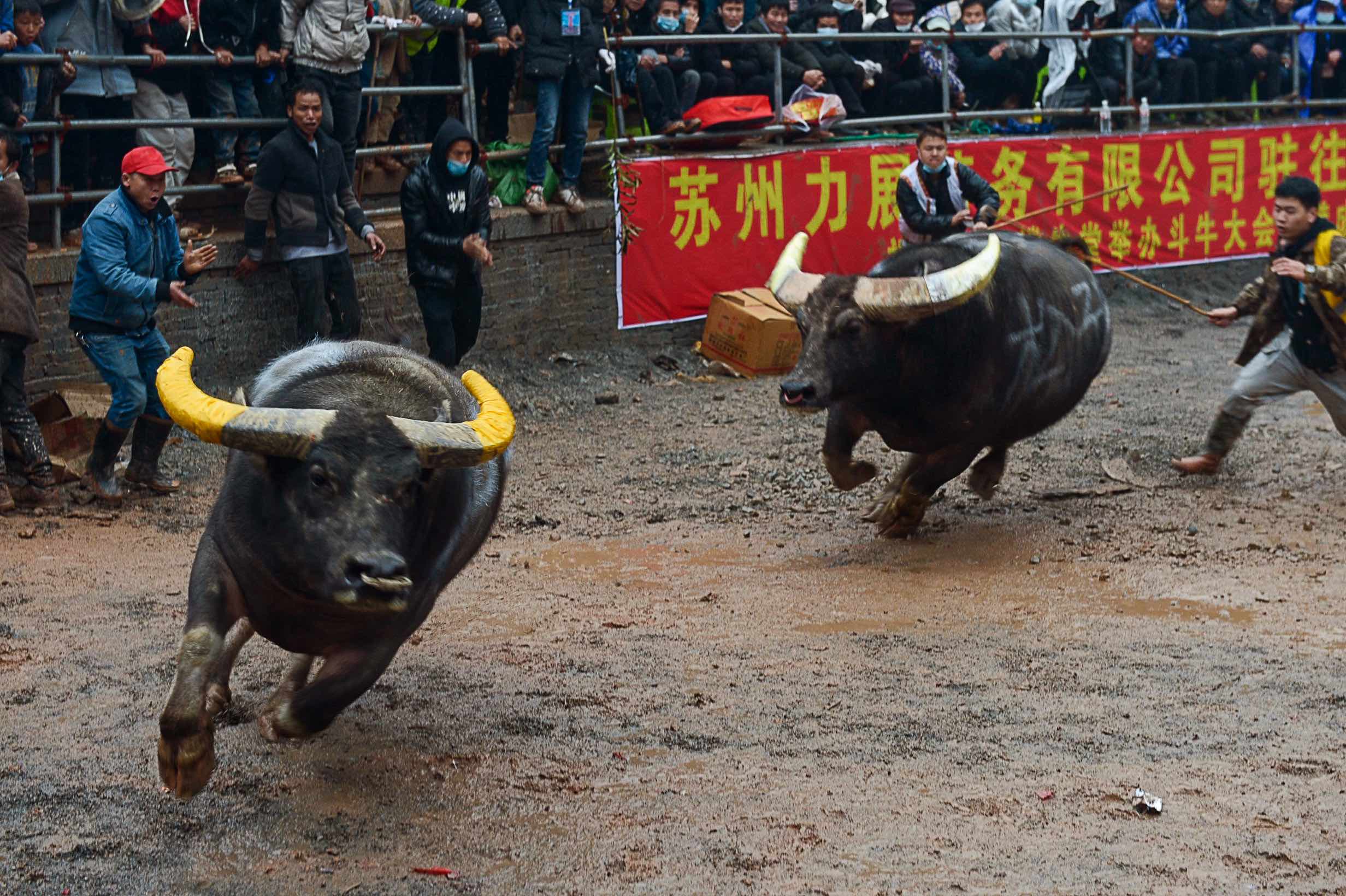
Cai Yuan runs away in defeat. Image by Lars Hamer/That's
[Cover image by Lars Hamer/That's]
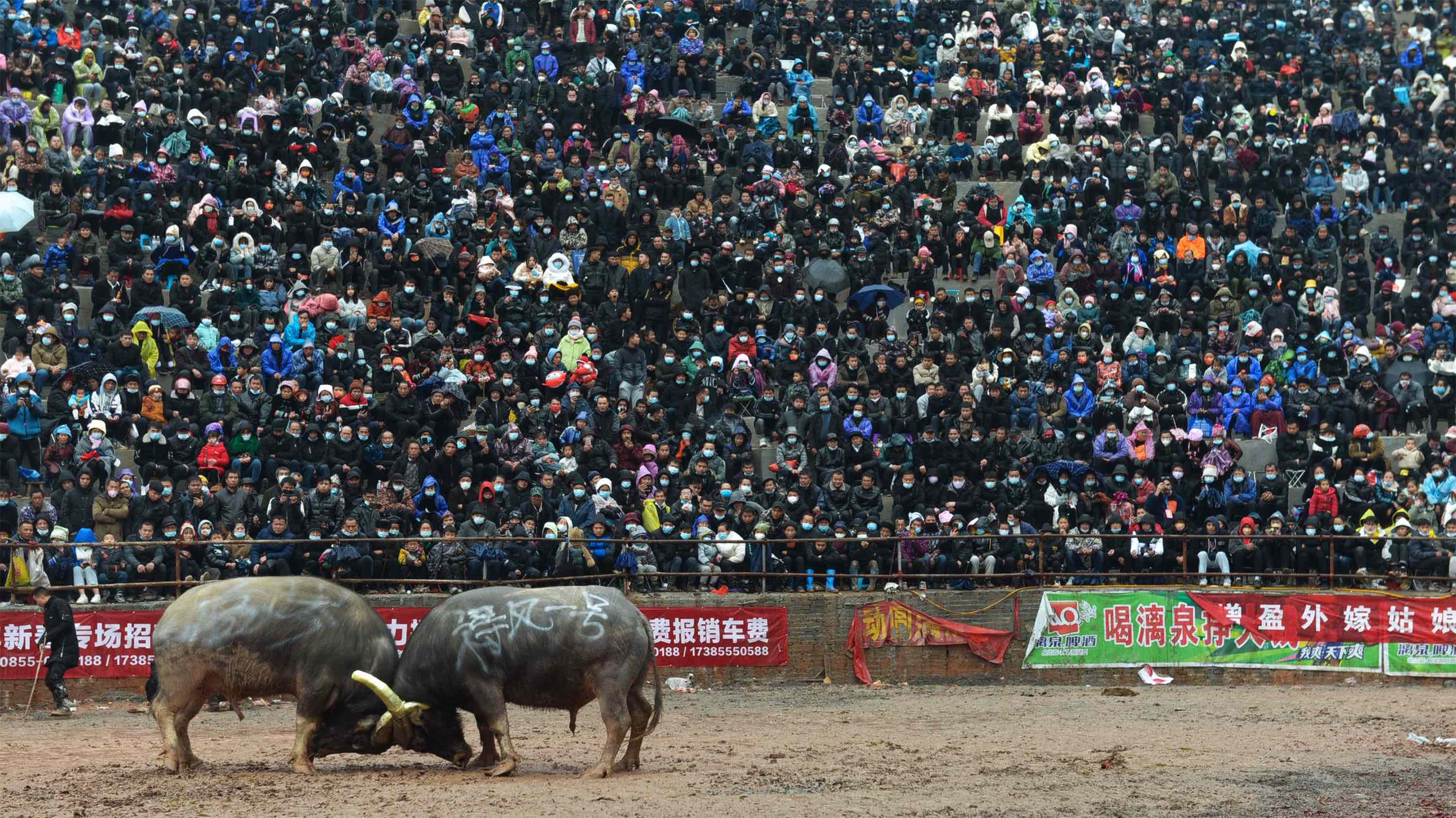





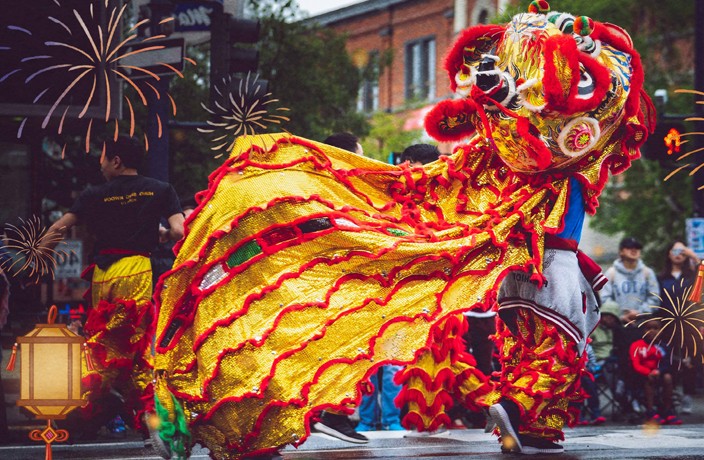















0 User Comments